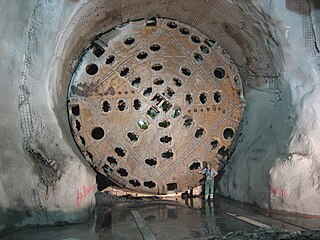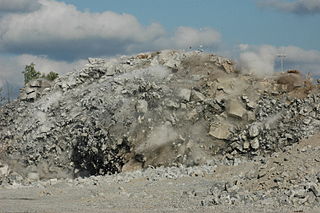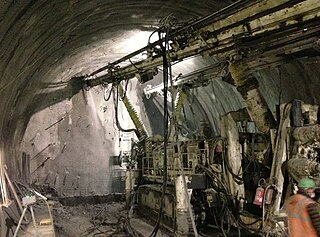
Geotechnical engineering, also known as geotechnics, is the branch of civil engineering concerned with the engineering behavior of earth materials. It uses the principles of soil mechanics and rock mechanics for the solution of its respective engineering problems. It also relies on knowledge of geology, hydrology, geophysics, and other related sciences.

Underground hard-rock mining refers to various underground mining techniques used to excavate "hard" minerals, usually those containing metals, such as ore containing gold, silver, iron, copper, zinc, nickel, tin, and lead. It also involves the same techniques used to excavate ores of gems, such as diamonds and rubies. Soft-rock mining refers to the excavation of softer minerals, such as salt, coal, and oil sands.
Climbing protection is any of a variety of devices employed to reduce risk and protect others while climbing rock and ice. It includes such items as nylon webbing and metal nuts, cams, bolts, and pitons.

Open-pit mining, also known as mega-mining, open-cast or open cut mining, is a surface mining technique of extracting rock or minerals from the earth by their removal from an open-air pit, sometimes known as a borrow.

Placer mining is the mining of stream bed (alluvial) deposits for minerals. This may be done by open-pit or by various surface excavating equipment or tunneling equipment.

This glossary of climbing terms is a list of definitions of terms and jargon related to rock climbing and mountaineering. The specific terms used can vary considerably between different English-speaking countries; many of the phrases described here are particular to the United States and the United Kingdom.

A tunnel boring machine (TBM), also known as a "mole", is a machine used to excavate tunnels with a circular cross section through a variety of soil and rock strata. They may also be used for microtunneling. They can be designed to bore through anything from hard rock to sand. Tunnel diameters can range from one metre (3.3 ft) to 17.6 metres (58 ft) to date. Tunnels of less than a metre or so in diameter are typically done using trenchless construction methods or horizontal directional drilling rather than TBMs. TBMs can also be designed to excavate non-circular tunnels, including u-shaped or horseshoe and square or rectangular tunnels.

Belaying is a variety of techniques climbers use to create friction within a climbing system, particularly on a climbing rope, so that a falling climber does not fall very far. A climbing partner typically applies tension at the other end of the rope whenever the climber is not moving, and removes the tension from the rope whenever the climber needs more rope to continue climbing.
The New Austrian tunneling method (NATM), also known as the sequential excavation method (SEM) or sprayed concrete lining method (SCL), is a method of modern tunnel design and construction employing sophisticated monitoring to optimize various wall reinforcement techniques based on the type of rock encountered as tunneling progresses. This technique first gained attention in the 1960s based on the work of Ladislaus von Rabcewicz, Leopold Müller, and Franz Pacher between 1957 and 1965 in Austria. The name NATM was intended to distinguish it from earlier methods, with its economic advantage of employing inherent geological strength available in the surrounding rock mass to stabilize the tunnel wherever possible rather than reinforcing the entire tunnel.

Surface mining, including strip mining, open-pit mining and mountaintop removal mining, is a broad category of mining in which soil and rock overlying the mineral deposit are removed, in contrast to underground mining, in which the overlying rock is left in place, and the mineral is removed through shafts or tunnels.

Rock mechanics is a theoretical and applied science of the mechanical behavior of rock and rock masses; compared to geology, it is that branch of mechanics concerned with the response of rock and rock masses to the force fields of their physical environment.

Shaft mining or shaft sinking is excavating a vertical or near-vertical tunnel from the top down, where there is initially no access to the bottom.

Drilling and blasting is the controlled use of explosives and other methods such as gas pressure blasting pyrotechnics, to break rock for excavation. It is practiced most often in mining, quarrying and civil engineering such as dam, tunnel or road construction. The result of rock blasting is often known as a rock cut.

Soil nailing is a construction remedial measure to treat unstable natural soil slopes or as a construction technique that allows the safe over-steepening of new or existing soil slopes. The technique involves the insertion of relatively slender reinforcing elements into the slope – often general purpose reinforcing bars (rebar) although proprietary solid or hollow-system bars are also available. Solid bars are usually installed into pre-drilled holes and then grouted into place using a separate grout line, whereas hollow bars may be drilled and grouted simultaneously by the use of a sacrificial drill bit and by pumping grout down the hollow bar as drilling progresses. Kinetic methods of firing relatively short bars into soil slopes have also been developed. Bars installed using drilling techniques are usually fully grouted and installed at a slight downward inclination with bars installed at regularly spaced points across the slope face. A rigid facing or isolated soil nail head plates may be used at the surface. Alternatively a flexible reinforcing mesh may be held against the soil face beneath the head plates. Rabbit proof wire mesh and environmental erosion control fabrics and may be used in conjunction with flexible mesh facing where environmental conditions dictate.
Geoprofessions is a term coined by the Geoprofessional Business Association to connote various technical disciplines that involve engineering, earth and environmental services applied to below-ground (“subsurface”), ground-surface, and ground-surface-connected conditions, structures, or formations. The principal disciplines include, as major categories:
Laubscher developed the Mining Rock Mass Rating (MRMR) system by modifying the Rock Mass Rating (RMR) system of Bieniawski. In the MRMR system the stability and support are determined with the following equations:
The rock mass rating (RMR) is a geomechanical classification system for rocks, developed by Z. T. Bieniawski between 1972 and 1973. Since then it has undergone multiple modifications out of which, RMR89 is commonly used. Recently RMR14 has been proposed to improve the RMR performance by incorporating new experiences from tunnel practices. Continuous functions and a software "QuickRMR" for RMR89 and RMR14 have also been proposed by Kundu. RMR combines the most significant geologic parameters of influence and represents them with one overall comprehensive index of rock mass quality, which is used for the design and construction of excavations in rock, such as tunnels, mines, slopes, and foundations.

Tunnels are dug in types of materials varying from soft clay to hard rock. The method of tunnel construction depends on such factors as the ground conditions, the ground water conditions, the length and diameter of the tunnel drive, the depth of the tunnel, the logistics of supporting the tunnel excavation, the final use and shape of the tunnel and appropriate risk management. Tunnel construction is a subset of underground construction.

Rock Bolting Development Site is a heritage-listed former rock bolt experiment site at Sharp Street, Cooma, Snowy Monaro Regional Council, New South Wales, Australia. It was used by Snowy Mountains Hydro-Electric Authority personnel from 1956 to 1962. It was added to the New South Wales State Heritage Register on 23 December 2016.

The Analysis of Controlled Deformation in Rocks and Soils, translated from Italian Analisi delle Deformazioni Controllate nelle Rocce e nei Suoli (ADECO-RS), also known as The New Italian Tunneling Method (NITM), is a modern tunnel design and construction approach. ADECO-RS was proposed by Pietro Lunardi in the 1980s on the basis of long in-depth research into the stress-strain behavior of more than 1,000 km of tunnel and more than 9,000 faces. In the past few decades, ADECO-RS has been widely used in Italian railway, highway and large underground construction projects and has been incorporated into Italian tunnel design and construction specifications.
















